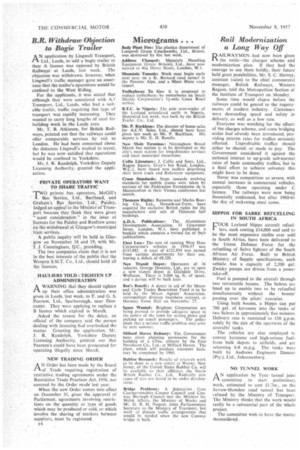Rail Modernization a Long Way Off D AILWAYMEN had now
Page 102

If you've noticed an error in this article please click here to report it so we can fix it.
been given the tools—the charges scheme and modernization plan. If they had the courage to use them boldly, their future held great possibilities, Mr. S. C. Harvey, assistant (sales) to the chief commercial manager, British Railways, Western Region, told the Metropolitan Section of the Institute of Transport on Monday.
Some time would elapse before the railways could be geared to the requirements of modern industry. Customers were demanding speed and safety ir delivery, as well as a low rate.
Everyone was watching for the effects of the charges scheme, and some bridging scales had already been introduced, providing interim rates for traffics seriously affected. Unprofitable traffics should either be shared, or made to pay. The Government considered it against the national interest to up-grade sub-normal rates of basic commodity traffics, but in a final effort to achieve solvency this might have to be done.
Never was competition so severe, with annual increases in commercial vehicles. especially those operating under C licence. The railways were now being financially cushioned, but after 1960-61 the day of reckoning must come.
HIPPOS FOR SABRE REFUELLING IN SOUTH AFRICA
POUR Leyland Hippo aircraft refuel.' lers, each costing £14,000 and said to be the most expensive outfits ever sold in South Africa, have been delivered to -the Union Defence Force for the refuelling of Sabre fighters of the South African Air Force. Built to British Ministry of Supply specifications, each vehicle has a capacity of 2,500 gal. Zwicky pumps are driven from a power take-off.
Fuel is pumped to the aircraft through two retractable booms. The Sabres are lined up to enable two to be refuelled simultaneously without the booms' passing over the pilots' canopies.
Using both booms, a Hippo can put 700 gal, of kerosene into the tanks of two Sabres in approximately five minutes. Delivery rate is restricted to 130 g.p.m. solely by the size of the apertures of the aircrafts' tanks.
The vehicles are also employed te convey kerosene and high-octane fuel. from bulk depots to airfields, and arc returning 6-8 m.p.g. The tanks were built by Andrews Engineers Duncan (Pty.), Ltd.. Johannesburg.
NO TUNNEL WORK
AN application by Tyne tunnel joint committee to start preliminary work, estimated to cost £1,7m., on the Jarrow-Howdon road tunnel has been refused by the Ministry of Transport. The Ministry thinks that the work would really be a substantial part of the whole project.
The committee wish to have the matter itconsidered.




























































































































































































































































